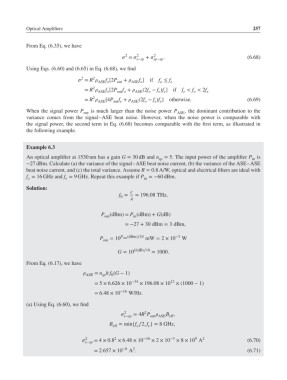Page 276 - Fiber Optic Communications Fund
P. 276
Optical Amplifiers 257
From Eq. (6.35), we have
2
= 2 s−sp + 2 sp−sp . (6.68)
Using Eqs. (6.60) and (6.65) in Eq. (6.68), we find
2
2
= R ASE o out + ASE o f ≤ f e
f ] if
f [2P
o
2
= R f [2P f + (2f − f )f ] if f < f < 2f
ASE o out o ASE o e e e o e
2
= R [4P f + (2f − f )f ] otherwise. (6.69)
ASE out e ASE o e e
When the signal power P is much larger than the noise power P , the dominant contribution to the
out ASE
variance comes from the signal–ASE beat noise. However, when the noise power is comparable with
the signal power, the second term in Eq. (6.68) becomes comparable with the first term, as illustrated in
the following example.
Example 6.3
An optical amplifier at 1530 nm has a gain G = 30 dB and n = 5. The input power of the amplifier P is
sp
in
−27 dBm. Calculate (a) the variance of the signal–ASE beat noise current, (b) the variance of the ASE–ASE
beat noise current, and (c) the total variance. Assume R = 0.8 A/W, optical and electrical filters are ideal with
f = 16 GHz and f = 9 GHz. Repeat this example if P =−60 dBm.
o
e
in
Solution:
c
f = = 196.08 THz,
0
P (dBm)= P (dBm)+ G(dB)
out in
=−27 + 30 dBm = 3dBm,
P = 10 P out (dBm)∕10 mW = 2 × 10 −3 W
out
G = 10 G(dB)∕10 = 1000.
From Eq. (6.17), we have
ASE = n hf (G − 1)
sp
0
12
= 5 × 6.626 × 10 −34 × 196.08 × 10 ×(1000 − 1)
= 6.48 × 10 −16 W/Hz.
(a) Using Eq. (6.60), we find
2
2 s−sp = 4R P B ,
out ASE eff
B = min{f ∕2, f }= 8 GHz,
eff o e
2 2 −16 −3 9 2
= 4 × 0.8 × 6.48 × 10 × 2 × 10 × 8 × 10 A (6.70)
s−sp
2
= 2.657 × 10 −8 A . (6.71)

